Landing technique: what is the winged infantry of Russia armed with
"Winged infantry" is equipped with both general military equipment and specially designed for specific tasks landing. These include BTR-80 armored personnel carriers, Tigr combat reconnaissance vehicles, Orlan-10 multifunctional UAVs, various anti-tank missile systems, self-propelled artillery mounts, mortars, howitzers, flamethrowers, grenade launchers, as well as portable anti-aircraft missile systems of short-range action.
The main equipment and weapons of the "winged infantry" - in the TASS material.
Future power of the Airborne Forces
Until the end of 2016, the "winged infantry" will receive a total of 144 latest assault vehicles BMD-4M "Gardener" and the armored personnel carrier BTR-MDM "Shell". It is planned to receive about 250 units of various vehicles for the Airborne Forces. By 2025, the latest combat vehicles must completely replace outdated armored vehicles, such as the BMD-2 and the BTR-D.
In addition, the troops received additional resources for developmental work on a wheeled vehicle for special forces with a combat module. Work on the modular wheeled armored airborne troops are carried out together with KamAZ.
For the "winged infantry" is being tested desanted version of the armored car "Tiger". Work is also underway to create a landing system for the Ptitselov anti-aircraft missile system based on BMD-4M.
In 2019, Zauralets is expected to appear in the landing forces of self-propelled artillery guns, and the Kornet anti-tank missile system is being developed, and Zavet-D artillery control vehicles are in developmental design.
In the interests of the Airborne Forces, the modernization of the 120-mm Nona self-propelled artillery, the Rheostat artillery fire control and artillery control unit, the 125-mm Sprut-SD self-propelled anti-tank gun continues.
BMD-2
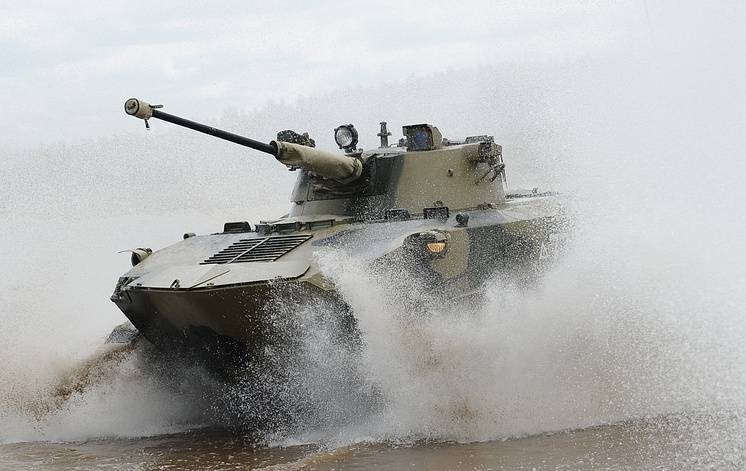
The BMD-2 "Budka" is a Soviet / Russian combat tracked amphibious vehicle. Created on the basis of BMD-1, intended for use in the Airborne Forces and landing by parachute or landing method from a military transport aircraft such as An-12, An-22 and Il-76. Adopted in 1985 year.
Baptism of an armored vehicle took place in hostilities in the Republic of Afghanistan. In subsequent years, BMD-2 was used in armed conflicts on the territory of Russia and abroad. It is in service in the armies of Russia, Kazakhstan and Ukraine.
BMD-2 is equipped with:
30-mm tool 2А42;
paired and course 7,62-mm PKT machine guns;
anti-tank missile complex 9М111 "Fagot" or 9М113 "Competition".
BMD-4M
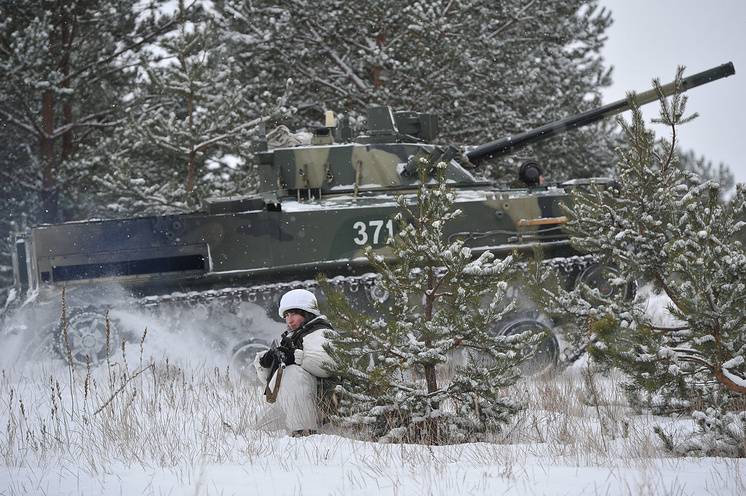
The BMD-4M airborne combat vehicle is a seriously upgraded version of the BMD-4 with a new hull, engine, chassis and other components.
The BMD-4M is equipped with the Bakhcha-U combat module, which includes 100 mm and 30 mm guns, as well as a machine gun.
The design of the machine allows you to parachute from the aircraft c crew inside.
The BMD-4 suspension has a telescopic hydraulic shock absorber that allows the car to rise / fall on the 40, see.
The BMD-4M fire control system includes a high-precision gunner's sight, stabilized in two planes and having a thermal imaging and distance measuring channels, which allows accurate fire on the move.
The composition of the basic weapons (according to data from open sources):
100-mm gun / launcher 2A70;
30-mm automatic gun 2А72;
7,62 mm PKTM machine gun;
ATGM 9М117М3 "Arkan";
ATGM 9М113 "Competition";
81-mm smoke smoke ZD6 (ЗД6М);
automatic grenade launcher AGS-30.
BTR-MDM "Shell"
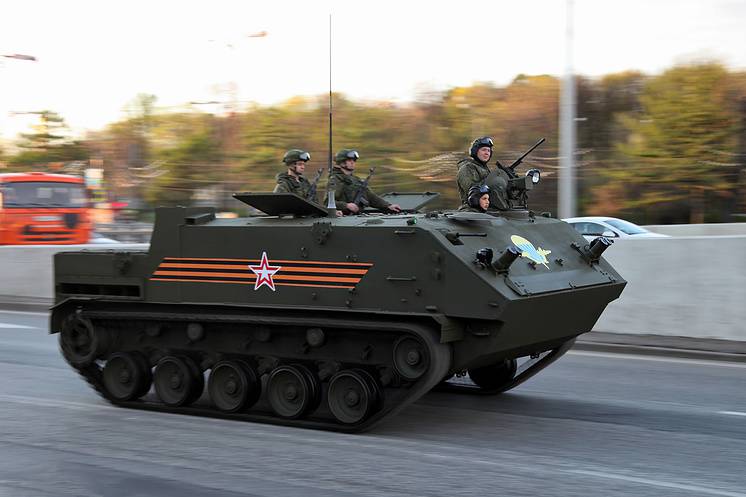
Amphibious armored personnel carrier BTR-MDM "Shell" ("955 Object"). Created on the basis of the BMD-4M airborne combat vehicle to replace the troops of the BTR-D landing armor, which was put into service as early as the 1970. Can be parachuted, is floating.
Combat crew: 15 man (crew member 2 and paratrooper 13).
Armament: two PKTM machine guns of caliber 7,62 mm (2 thousand cartridges for each).
Maximum speed: 70 km / h on the highway, 45-50 km / h over rough terrain, 10 km / h afloat.
Combat weight: 13,2 t.
Power reserve: 500 km on the highway, 350 km over rough terrain.
The BTR-MDM can be parachuted by parachute, is floating.
Adopted by the Armed Forces of the Russian Federation in April 2016.
Self-propelled gun "Sprut-SD"
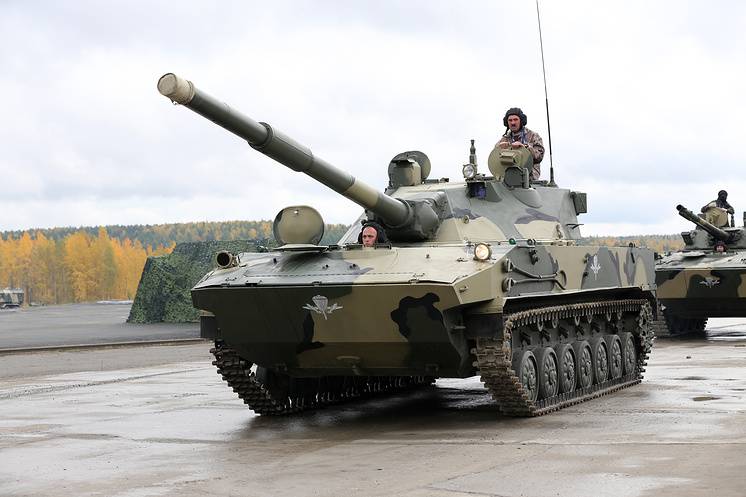
The basic model of the Sprut-SD ("self-propelled", "landing" - approx. TASS) is an airborne self-propelled anti-tank gun caliber 125 mm, designed to combat armored vehicles and manpower of the enemy as part of the airborne unit, marines and special forces.
The first sample of the upgraded car has already been created. It was reported that he received a digital fire control system and engine from an infantry fighting vehicle BMP-3.
According to data from open sources, the Sprut-SD is equipped with a unique hydropneumatic chassis that allows the combat vehicle to move smoothly and quickly in off-road conditions at speeds up to 70 km / h, which significantly improves the conditions for firing in motion.
In addition, the self-propelled gun is able to overcome water obstacles at a speed of afloat to 10 km / h. The machine can parachute from the cargo ships to the water surface and independently returns to the ship.
The Octopus-SD gun was created on the basis of 125 mm tank guns 2A46, which is installed on the T-72, T-80 and T-90 tanks. As an auxiliary weapon, the machine is equipped with a 7,62 mm machine gun coaxial with a cannon with an ammunition of 2000 rounds.
It is expected that the mass production of the modernized Sprut-SDM-1 self-propelled anti-tank gun for the Airborne Forces will begin in the 2018 year.
AC-1 snowmobile
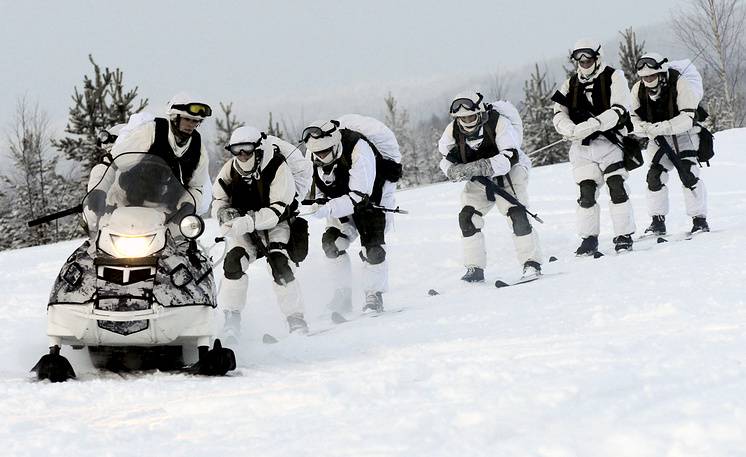
AC-1 - Army snowmobile high cross.
Designed to perform operational tasks by mobile crews behind enemy lines and quickly retreating to their initial positions, conducting reconnaissance and patrol operations, raiding and search and rescue operations in various conditions, including in the Arctic regions.
The basis for creating the AC-1 was the well-proven model "Taiga Patrol 551 SVT" with a two-cylinder RMZ-551 two-cylinder engine with a capacity of 65 l. with.
Since the beginning of 2016, 10 snowmobiles have received units deployed in the Western Military District.
Specifications:
Length - 2950 mm, width with skis - 1150 mm.
Weight - 320 kg.
Fuel tank capacity - 55 l.
Transmission - two-stage with reverse.
The maximum speed is 80 km / h.
LAW "Strela-10"
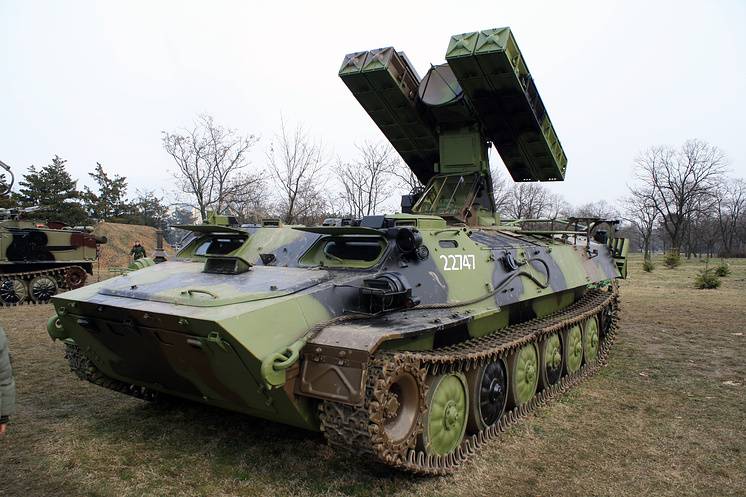
The Airborne Forces have various modifications of the Strela-10 anti-aircraft missile system, the basic model of which was put into service in the 1976 year.
The Strela-10 anti-aircraft missile system is designed to protect military units in various forms of combat and on the march from airborne attack and reconnaissance equipment diving and flying at low and very low altitudes.
The new version of Strela-10MN (night) has the possibility of night autonomous sector search and target detection, it can work at night by entering autonomous sector search and target detection.
The anti-aircraft missile system is used to shield military formations from airborne objects. Such objects can be not only airplanes, but also unmanned aerial vehicles carrying out reconnaissance and flying at ultra-low altitudes. According to experts, the Strela-10MN is also effective against diving air objects.
Now, on the basis of the BMD-4M combat vehicle, the first in the world airborne anti-aircraft missile system Ptitselov is being created.
MANPADS "Igla" and "Verba"
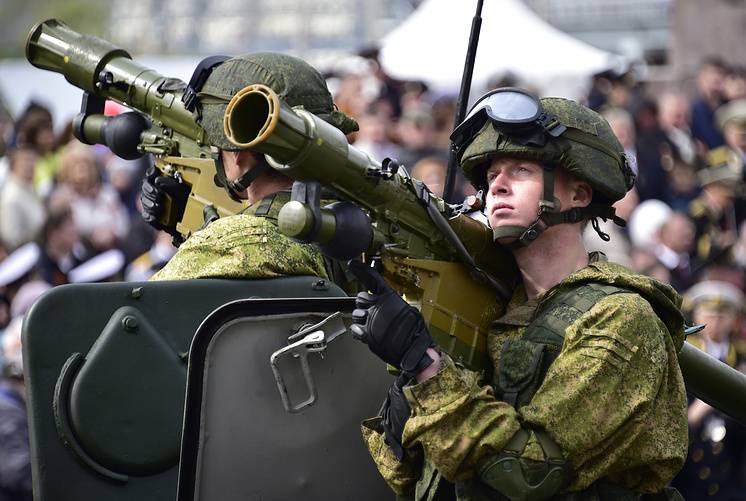
The Igla is a Russian and Soviet portable anti-aircraft missile system (MANPADS) designed to destroy low-flying air targets on head-on and catch-up courses under the influence of false heat interference. The complex was put into service in 1983 year.
The development of a fundamentally new complex began in Kolomna in 1971 year. The Igla complex was supposed to change the Strela complexes belonging to the previous generation of MANPADS and having lower technical characteristics. The main advantage of the Igla MANPADS is the best resistance to countermeasures and higher combat effectiveness.
There are a number of modifications of MANPADS, in particular the Igla-S complex, capable of hitting low-flying cruise missiles and Drones. The complex is in service with the armies of Russia, the CIS countries, and since 1994 it has been exported to more than 30 countries.
In 2015, the Ministry of Defense of the Russian Federation began to receive the first portable Verba anti-aircraft systems.
MANPADS "willow", according to the developers, in its characteristics surpasses all existing foreign samples. The anti-aircraft missile, which is part of the complex, for the first time in the world received a three-spectral homing head with increased sensitivity and can hit low-emitting targets.
The complex is capable of destroying targets at altitudes from 10 to 4,5 thousand meters and at a distance from 500 to 6,5 thousand meters. At least 10 once increased the security of the complex for pyrotechnic interference. In 1,5-2 times the combat effectiveness of the complex is increased.
According to the developers, this became possible due to a set of innovations and improved characteristics of MANPADS. The complex has a higher shooting accuracy. In Verba, the practice of using the “friend-foe” query has been resumed.
Information